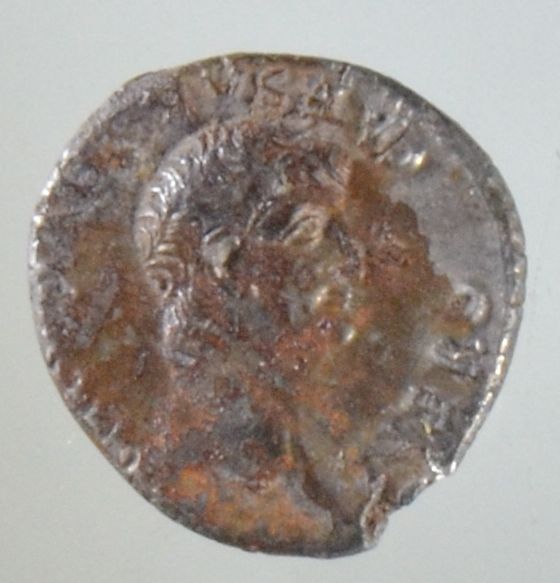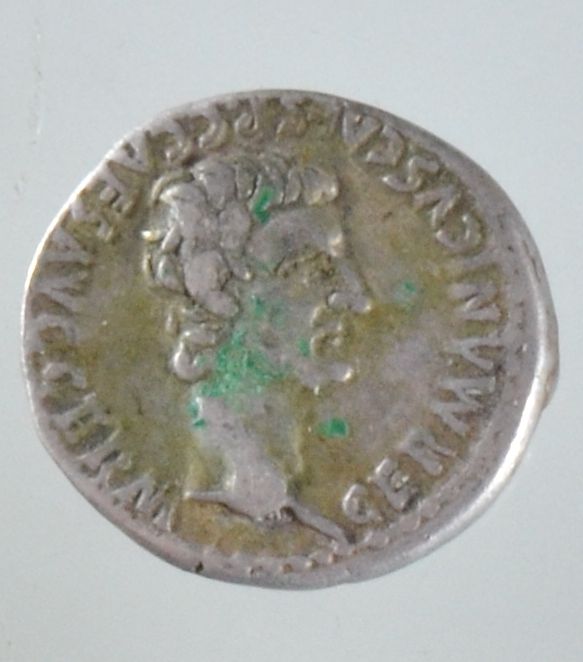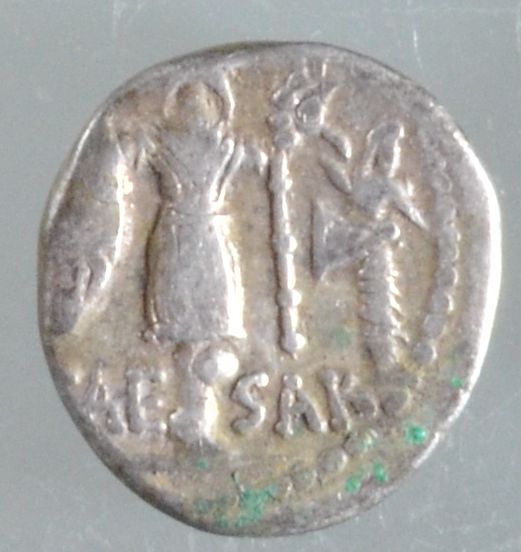Thanks to the generous donations from our Museum Friends and Supporters, together with the Victoria and Albert Museum Purchase Grant Fund and the Headley Trust we have raised the funds to purchase this hoard. Thank you all. The coins are still in the British Museum, awaiting collection when it is safe to do so.
WordPress Tables Plugin
The Halesworth and District Museum is pleased to say that it has recently purchased (May 2020) a hoard of Silver Roman Denarii discovered in Cookley. We have yet to collect them from the British Museum, which we will do once normal times resume.
There are 58 silver coins and two forgeries in this hoard, which cost £4,500. We have been fortunate to receive funding from the V&A Grant Fund and the Headley Trust of £3,500 but further donations to help the Museum cover the cost of this very important addition to its collections will be welcome.
A brief description of the hoard and of some example coins follows. If you want a more detailed description see the Report for H M Coroner – Treasure Number: 2018T677:
The ‘Near Cookley’ hoard was discovered on the 19th of August 2018 by a metal detectorist on a cultivated field with the landowner’s permission. He initially discovered twelve silver denarii, and on returning to the field the next day dug out another 48 from some depth – apparently around 18 inches. The initial finds were spread over ‘a few yards’, but those recovered deeper appear to have been unfortunately dug out of an archaeological context. No pottery sherds were observed by the finder, and thus it seems probable that the coins were buried in an organic container that had since disintegrated. The closely packed nature of the coins is demonstrable by the base-metal traces that have leached to the surfaces of the coins during burial and mutually encrusted/stained each other. Having recovered what appeared to be all the coins, the finder reported the hoard on the 22nd of August and transported it to the SCCAS offices on the 5th of September, where they were identified and a report written.
One of the interesting things about this collection of coins is that two thirds of the coins were minted before 27BC, way before the invasion of Britain by the Emperor Claudius in 43AD. Why did they end up in Cookley? Are they an example of trade between Roman and late Iron Age Britain or is there another explanation?
The youngest coin found (coin 1) is of Nero and dates to AD 60-61 and therefore gives some indication of when the hoard was buried or hidden. The significance of the date is that it is precisely at the time of the Iceni Boudica revolt against Roman rule. Was the hoard buried by a worried Roman, or loot hidden by an Iceni during the revolt? The oldest coin from the collection (coin 59) is from the Republican era, dated 155 BC. We know that Roman coins were often in circulation for over 200 years, but this hoard seems to have a high proportion of very old, well circulated coins. All the coins are silver denarii, there are no lower value coins. It is also curious that the hoard lacks any coins that were minted in the twenty or so years before the lone Nero coin (i.e. no coins of Claudius, the emperor before Nero). A significant number of the post-27 BC coins were minted in Lugdunum (Lyon in France) which was the Roman capital of Gaul, which may give some indication of where in the Empire the original owner came from, although there were no Roman coins minted in Britain till centuries after the invasion.
It is tempting to hypothesise that these coins belonged to a Roman or Gaulish trader who came over to Britain in the years immediately after the Claudian invasion with a bag of old silver coins to do business in the new colony. Sadly they then became a victim of the Boudican revolt.
Another possibility in the light of other hoards of old Roman and Iron age coins being found within miles of this hoard is that they were family savings of recent settlers, looted (or hidden) from/in an undiscovered early villa or small Roman settlement somewhere in the immediate local area that was somehow caught up in the Boudican revolt. They could of course also be hidden loot taken by an Iceni warrior returning home from the sacking of towns like Colchester and, for whatever reason, never reclaimed.
| | |
|---|
| Nero: (Coin 1) | | |
 |  | This coin is probably the most important of the hoard, and not purely because it has the head of the notorious emperor on it. Being the youngest coin in the hoard it gives us a good idea of when the coins were lost, buried or looted at the time of the Boudican revolt in AD 60-61. The coin was minted in Rome and shows the bust of Nero. The reverse of the coin shows a wreath with the symbols EX SC, meaning by order of the senate. The wreath was used as a symbol of victory or saving the life of civilians. Given Nero’s subsequent actions this symbol is somewhat ironic! |
| Caligula: (Coin 2) | | |
 |  | This rare coin is of the infamous emperor who reigned for only four years. As well as being accused of smothering to death the previous emperor Tiberius, he was accused of cruelty, sadism, extravagance, and incest with his sisters. He thought himself a god and demanded worship. He also made his horse a consul in the senate. His reign of paranoia and fear came to an end when he was assassinated by officers of the Praetorian Guard in AD 41. The reverse of the coin shows the deified Augustus Caesar, the message being that Caligula, his great-grandson was descended from a god. |
| Republican era: (Coin 59) | | |
 |  | Dated to 153BC. This coin was minted in Rome by C Maianus. This is the oldest coin in the collection, some 210 or more years older than the youngest coin in the collection (Nero). It is worn and maintained its value because of the silver content. The helmeted head on the coin is a standard “republican” era design. The reverse of the coin shows Victory, holding a whip and reins, driving a biga (a two-wheel chariot). This could be a reference to Roman victories over the Greeks during this period. |
| Augustus Caesar 27BC-14AD (Coin 17) | | |
 |  | An interesting feature is the reverse of the coin that shows Capricorn holding a globe. Astrology has ancient roots and Augustus was clearly interested in the subject. He was born under the star sign of Capricorn. The globe is the Roman symbol of the world. Curious to think that the Romans seemed to know the world was round, and this knowledge was lost for centuries. The meaning of the symbols on this coin is therefore that “Augustus rules the world!” |
| Julius Caesar 47-48 BC (Coin 39) | | |
 |  | This coin was minted on campaign with Julius Caesar. The obverse is not a bust of Caesar but represents the virtues of either mercy (Clementia) or dutifulness (Pietas). To the left of the bust is the Roman numeral LII, indicating Caesars age when the coin was minted (52). The reverse represents Caesar’s triumphs in Gaul (France): a helmet, cuirass (breastplate), shield, and carynx (a type of trumpet). On the extreme right is a securis victimaria (axe). This was a sacred axe used rather gruesomely to divide the bones and flesh of the victim into many parts. It was used symbolically to represent power, especially of consuls who had left Rome to join the army. A version of this axe was also used as the symbol of Mussolini’s Italian fascist movement. All these symbols are signs of military victory and conquest. |
| Tiberius (Coin 4) | | |
 |  | This coin shows the bust of the severe and unpopular Emperor, and dates to around 14-37 AD. On the reverse of the coin Tiberius showed the revered Livia, wife of Augustus, his mother, in the pose of Pax the goddess of peace, seated with a tall sceptre and olive branch. This familiar design was later used by the Romans to represent Britannia on coins and has become a regular feature on the reverse of British coins from Charles II to modern times. This is the coin which is usually identified as the Biblical “Tribute Penny” of Saint Matthew, to be “rendered unto Caesar”. This coin was minted in Lugdundum (Lyon in France). |
| Pompey Magnus (Minor?) 45-46 BC (Coin 35). | | |
 |  | Pompey Magnus Minor was the son of Julius Caesar’s great rival Pompey Magnus who had been assassinated in Egypt on the orders of Cleopatra’s brother Ptolemy, in 48BC. This coin can be dated to a precise time and place in this ongoing civil war. It was struck by a moneyer called M Poblicius. The obverse of the coin shows the head of Roma, a standard design of the republican era. The reverse of the coin shows Hispania (Spain) presenting a palm branch to a Roman soldier standing on a prow (the front, pointed part of a ship). The coin was minted in Colonia Patricia (Cordoba, Spain). Spain was a stronghold of Pompey and his sons, and the image represents Spain offering Pompey Magnus Minor victory (both the branch and prow are its symbols). Sadly this was not the case, Colonia Patricia was sacked by Julius Caesar in BC 45 and Pompey Magnus Minor was executed after the battle of Munda in the same year! |
| Mark Anthony 41 BC. (Coin 31) | | |
 |  | Mark Anthony was Julius Caesar’s friend and second-in-command. After Caesar’s assassination he formed a fragile alliance with Ceasar’s nephew Octavian (Later Augustus Caesar) and the Empire was divided between them and a third leader called Lepidus. This coin shows the bust of Anthony on the obverse and Octavian on the reverse. It was minted by a moneyer called Marcus Barbatius, a key ally of Mark Anthony. The coin was produced in Anthony’s new powerbase in the east of the Roman Empire. This new sphere of influence led to his fateful meeting with Cleopatra in the year this coin was minted. Many of Mark Anthony’s coins were minted on campaign in reused silver to pay his troops. |
















